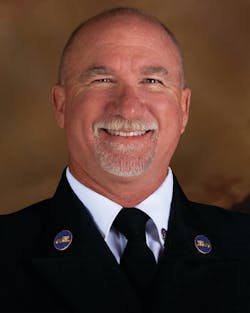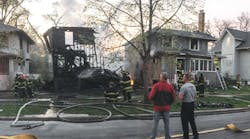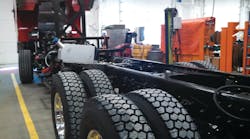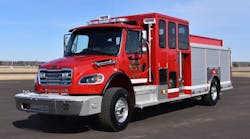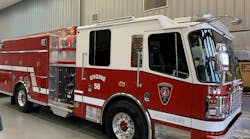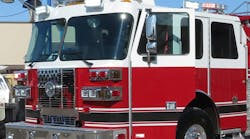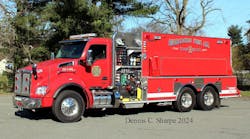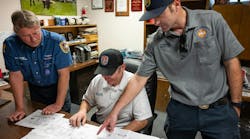For most of us in the fire service, buying new apparatus is not an everyday occurrence. It can be challenging and fraught with costly missteps. Fortunately, there are many people who have bought numerous fire apparatus over the years and are willing to share their experiences.
Firehouse® Magazine has spoken with several experts across the country who shared their decades of knowledge and expert tips so that we won’t end up paying too much for apparatus that won’t do what we want. Those consulted for advice were: Crosby Grindle, vice president of the government division of National Purchasing Partners & Fire Rescue GPO; Timothy Calhoun, director of fleet services, Palm Beach County, FL, Fire Rescue; Greg Stone, a captain with the Los Angeles Fire Department and founder of East West Fire Apparatus Consultants; and Anthony Bulygo, a retired master mechanic from the Santa Clara County, CA, Fire Department and current operator of Bulygo & Associates Fire Apparatus Consulting. All four advocate well-thought-out specifications and a knowledgeable purchasing agent or committee to avoid any surprises and disappointments on delivery day. Here’s a more specific look at what each expert had to say.
“Piggy backing” on bids
Crosby Grindle works for a company that advocates group purchasing and “piggy backing” on bids received from by other departments.
“Any kind of piggy backing saves having to go out for a request for proposal and usually results in better pricing,” Grindle said, adding that having a clear expectation of what the apparatus is supposed to do and what it will look like at the outset will have a big effect on the end results and will usually mean people won’t be surprised by anything when the apparatus is finished.
Department expectations and requirements should be clearly outlined pre-bid conferences and at bid awards. Change orders after the bid has been awarded can cost huge amounts of money and drive up the cost of apparatus significantly, Grindle said. He acknowledged that fire departments and truck committees are political in nature and many times, they will include individuals with the need to engineer apparatus from the ground up. “Don’t do that,” Grindle advised. “It’s unlikely that water flows differently in your community, or the trucks go down the road a different way.”
That doesn’t mean that people should “settle” for apparatus that will not do the job they desire or fit the bill in other ways. “People should just really look at what they propose and make sure it adds value to the process,” he said.
Grindle believes there may be just a bit too much customization on fire apparatus in the U.S. At the core, the mission of fire apparatus is virtually the same from coast to coast, he said. They haul water, people and tools from the station to the scene, he said.
Using United Parcel Service (UPS) as an example, Grindle said that company has a fleet of brown trucks that are identical everywhere they are used. It’s a process that saves money and time. Grindle said he understands the mission of fire apparatus is far more serious and faulty or inferior equipment can be life threatening. “I am not saying fire trucks are like UPS trucks, but there are some lessons to be learned,” he said. “You just have to use some common sense.”
When selecting a sales representative or manufacturer, Grindle said departments need to look at how responsive the personnel are and their abilities to answer questions. “If they are not responsive or answering your questions, it might be an indication of what will happen in the future,” he said.
Grindle also advises departments to look at service and warranty conditions to make sure they are as good as the departments believe they are and as represented by the vendor. When bidding, Grindle suggested that fire departments check with their municipalities and legal counsel to make sure all the rules are being followed.
“You don’t want to get sideways with them and have a vendor say you’re doing something inappropriately,” Grindle said. “Everyone needs to know the rules of the game even before you get going too far.”
“Define what you really need”
Anthony Bulygo has been in the business of buying and fixing fire apparatus for more than 40 years. He has worked with legacy names like Hahn and even has a dealt with a few World War II military vehicles converted into fire apparatus. Lately, through his consulting business based in Bakersfield, CA, he has been dealing with the most modern and high-tech apparatus around.
Right out of the gate, Bulygo assured fire departments shopping for a new rig that virtually all manufacturers build high-quality National Fire Protection Association (NFPA)-compliant apparatus. “Start out by defining the need rather than thinking you need to by XYZ Brand,” he said. “Define what you really need first, then find the builder who will build what you want. Don’t do the reverse.”
Bulygo said an apparatus committee is a good place to start in the process of getting a new truck in the station. That is, however, if the department does not have a fire chief or purchasing agent with the sole responsibility of acquiring new apparatus. A committee should have a chief officer in the mix, he said – someone with “horsepower” to make a monetary decision – and then perhaps a battalion chief and if the department is full-time career, one representative from each shift. A line officer or two may be a good idea, he said, adding that at least one person on the committee should have mechanical aptitude, at least to the level that the person would recognize something does not sound right or would not work on a practical level. “Now you have a committee and you can start writing specifications for bids,” Bulygo said.
While some departments go with manufacturer-supplied specifications and boilerplate verbiage, Bulygo said could mean departments pay more for apparatus than they should. “My advice is to make the specifications as generic as possible so any number of people can bid on it,” he said noting that competitive bidding often leads to the best prices and values. Using specific bids, designed to eliminate bidders or at least steer the bid to one particular vendor, can lead to legal challenges from a losing bidder, he said.
There are a number of important topics departments should have some specificity built into the specifications, Bulygo said. For instance, fire departments may want to limit the distance they will have to travel to have warranty work done on the apparatus, he said, noting that in rural areas the distance can be up to 300 miles, which is not desirable for an emergency vehicle. The vehicle will be out of service for a considerable time even for the most minor work and the staff needed to take the vehicle there is excessive. He said it is perfectly acceptable to specify a certain number of miles departments are willing to travel for service and make it part of the bid.
Common sense must come into play, however, he said, noting that he knows of one department that specified that the point of warranty work couldn’t be more than 5½ miles from the station. Clearly, that department wanted to deal with a particular manufacturer that had a service center close by, he said, noting that it was legitimate, but may have been a bit too restrictive to be competitive.
Bulygo said it is important that manufacturers know the climate in which apparatus is being used. Boilerplate specifications may over look that aspect of a department’s needs and departments can find themselves with apparatus that cannot perform in hilly terrain or handle extreme differentials in temperatures. For instance, Bulygo said, the NFPA requires parking brakes to hold on grades of up to 20%, but California law requires parking brakes to hold to the point where tires lose traction – a much more stringent requirement.
Bulygo is an advocate of pre-bid conferences where all potential bidders are given an opportunity to air any gripes or misgivings they have about the bid or make exceptions and ask for clarification of certain features of the apparatus being requested. “It’s also the time for the companies to argue the standards and make their case for exceptions to the bid,” he said.
Moving to the next step, awarding of bid, Bulygo said the committee, or whoever is making the purchase, must look at the bids and evaluate their responsiveness to the specification. He said he once reviewed a bid that was significantly lower than any of the others, but completely unresponsive to the specification. It reduced the horsepower of the engine significantly and shortened the aerial as well, leading to sizeable reduction in price, but it was not what the department wanted. That bid was completely dismissed and not considered any further, he said.
After the bid is awarded, Bulygo said it is important for the department to have one point person at the company who will handle all the communication with the manufacturer and answer questions. Also, there should be one person, or a small number of people, who can authorize change orders as the apparatus is built, he said. If everyone on the committee has the right to make a change, the apparatus that rolls off the line might look dramatically different than what was originally specified and be considerably more expensive.
Along those same lines, Bulygo said there should be a core of people who follow the apparatus all the way through the production and delivery period. Too often, different people go to the pre-construction conference, the pre-paint inspection and the final delivery inspection. The change of personnel through the process can lead to some miscommunication and surprises at the time of delivery, he said.
During the final inspection, fire departments should request that it be done at the factory in a separate area, away from the production area with a pit or lift available and lights for a complete inspection and evaluation, he said. “You want a complete punch list of everything that is supposed to be on that apparatus and you want to check everything,” he said. If anything is wrong, or needs taking care of, it will be done right at the factory.
As far as delivery itself goes, it is best that the apparatus is driven to its final home for a “shakedown” to make sure nothing is going to break, or if it does, the department hasn’t taken delivery of it yet and it remains the responsibility of the manufacturer to handle any repairs or remedies.
Bulygo said he is impressed with the quality of apparatus that has been produced lately and he’s is confident nearly all the apparatus manufacturers in business today are very capable of producing high-quality apparatus that will perform well for years.
“It wasn’t always like that, but they’ve really stepped up and most of them are totally responsive,” Bulygo said.
Apparatus reliability
For at least the past 25 years, Tim Calhoun has been involved in fleet maintenance. He started as the Palm Beach County fleet support supervisor in 1989 and he has worked with Palm Beach County Fire Rescue as director of the fleet since 2007. Between stints with Palm Beach County, he worked for Florida Power Light in its automotive engineering department and with the City of Boynton Beach as a fleet administrator. Needless to say, he has specified and purchases for more than a few fire trucks.
“We certainly look at apparatus purchasing from a maintenance side,” Calhoun said. “…I want the lowest-cost piece of equipment that’s reliable and isn’t in my shop all the time.”
Calhoun said he is a firm believer in competitive bidding and has always tried to write an open bid, with input from officers, union representatives and the people who will be using the apparatus most. If there’s a way to piggy back off another contract, he’s willing to do that to save money. And, he’s not shy about deleting some equipment on the particular contract to save a few bucks. “We work with vendors to get specifically what we want,” he said.
Another way his department saves money is to remount bodies for brush trucks and ambulances, he said. Recently, Palm Beach County saved $110,000 each on two brush trucks that were remounted on new cabs and chassis, Calhoun said. And, he is having a fleet of ambulances remounted, saving $75,000 on each unit which saves a ton of money.
“My goal is to set two ambulances side by side and challenge people to pick the new one,” Calhoun said, adding the metal box bodies are completely gutted with all new interiors installed and refurbished.
Calhoun said the real challenge will be to see if he can remount the bodies three, or even four times before having to retire the units. “Having them remounted once is a success story,” Calhoun said. “Having them remounted three or four times will be the real success story.”
Calhoun noted that all manufacturers of apparatus use the same basic components and install them on cabs and chassis that are essentially the same with similar motors. For him, the distinguishing factor is “who is going to support your product the best,” he said.
“It all comes down to the relationship you develop with the manufacturer,” Calhoun said, adding that a “good, honest salesperson” is just as invaluable. “Take the time to listen to the salesperson. Open, honest communication is important. …If you think you know it all, you’ll miss out. You need to keep an open mind or you might miss out on an opportunity.”
Getting what’s needed
Greg Stone is a retired Los Angeles Fire Department officer with 33 years’ experience. For a time, he was the procurement officer for the city with responsibilities for purchasing the department’s and apparatus and other equipment. Upon his retirement, he partnered with Ken Wagner, who has been with the New York City Fire Department for more than 20 years and the Pleasantville, NY, Volunteer Fire Department for more than 27 years. Together, Stone and Wagner formed East West Fire Apparatus Consultants, a business that helps departments write and review specifications and acquire apparatus. They can be found at http://www.ewfac.com.
Lately, Stone said his business has been getting calls from purchasing agents and city managers who want to validate their communities’ bidding process and make sure they are getting what’s needed. Stone said a consultant can help communities avoid the pitfalls of overly specific requirements that can result in challenges from bidders.
“We recommend thoroughly open bidding,” Stone said. “For instance, you’ll want to specify an alternator capable of handling the load, rather than specifying a certain kind of alternator.”
Another example is compartment size, he said, noting that specifying 25¾-inch compartments, with no exceptions, will eliminate some competitive bidders. The same holds true for specifications for one-piece windshields and certain brands of independent front suspensions, Stone said, adding that vendors and manufacturers know enough about their competition to determine the department is looking for a particular brand of apparatus and will not submit a bid for fear of wasting time.
There may be legitimate reasons for specifying particular features, but departments must know that it will likely reduce the number of bidders or significantly increase the number of exceptions vendors take to the bids, Stone said.
Stone’s company recently helped with a specification and bidding process on a refinery apparatus. They made the specifications open and generic and got five bidders on the apparatus. “And we changed only 10 things from the bid we went with,” Stone said, noting that the process was efficient and painless.
Stone said he has seen the extremes for bid specifications as some departments insist on specifying every single detail to the point of being silly. He said that process is often a disservice to the department and the community because what is delivered is not what is needed and the cost can be substantially more.
“I think a lot of small fire departments lose track of who is paying for the vehicles and that’s the taxpayers,” Stone said. “Not only are they abusing purchasing rules, I believe it’s morally wrong. They’re taking advantage of the system and going around the lowest bid.”
Stone said the best advice he can offer is to have fire departments write “good, solid specs” and then look for manufacturers that can provide the best service with emergency vehicle technicians available 24 hours a day. “A sales rep can be your biggest ally in the process,” he said. “You’ll almost always get a better deal at the factory working through a sales rep.”
Stone acknowledged that sales representatives have a vested interest in keeping the customer happy during the process by running interference at the factory and pushing through any changes that might come up during the build process. “Most fire truck sales reps are really good at what they do and you should use them,” he said.
Stone said fire departments need to keep track of how the apparatus is being built and making sure everything that was specified is on the apparatus and of the correct specifications.
“You don’t want to get to the final inspection and find out the engine they put in is too small,” he said. “Go through the specifications line by line and make sure everything is what it should be…. Remember that when you sign off on something, you bought it.”
